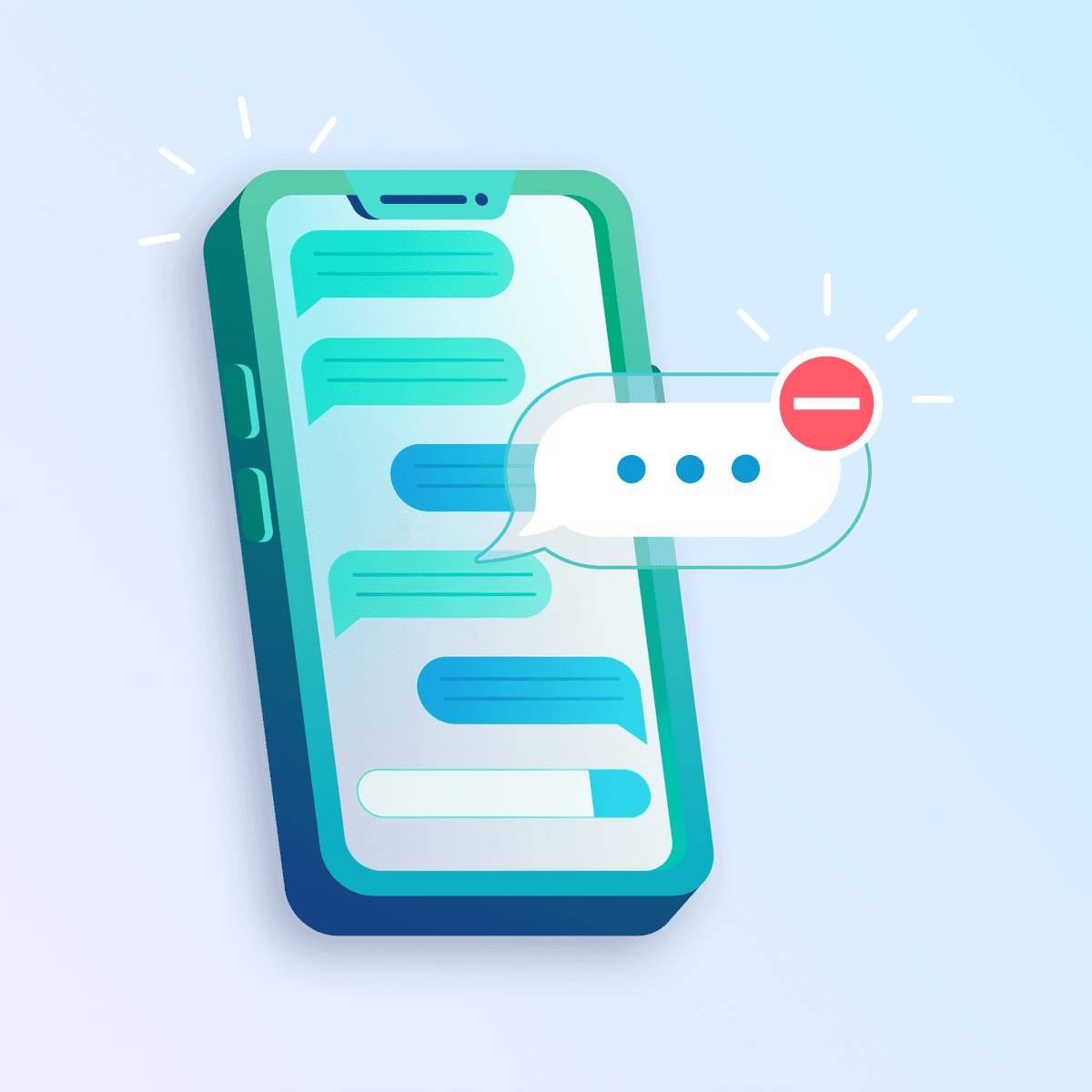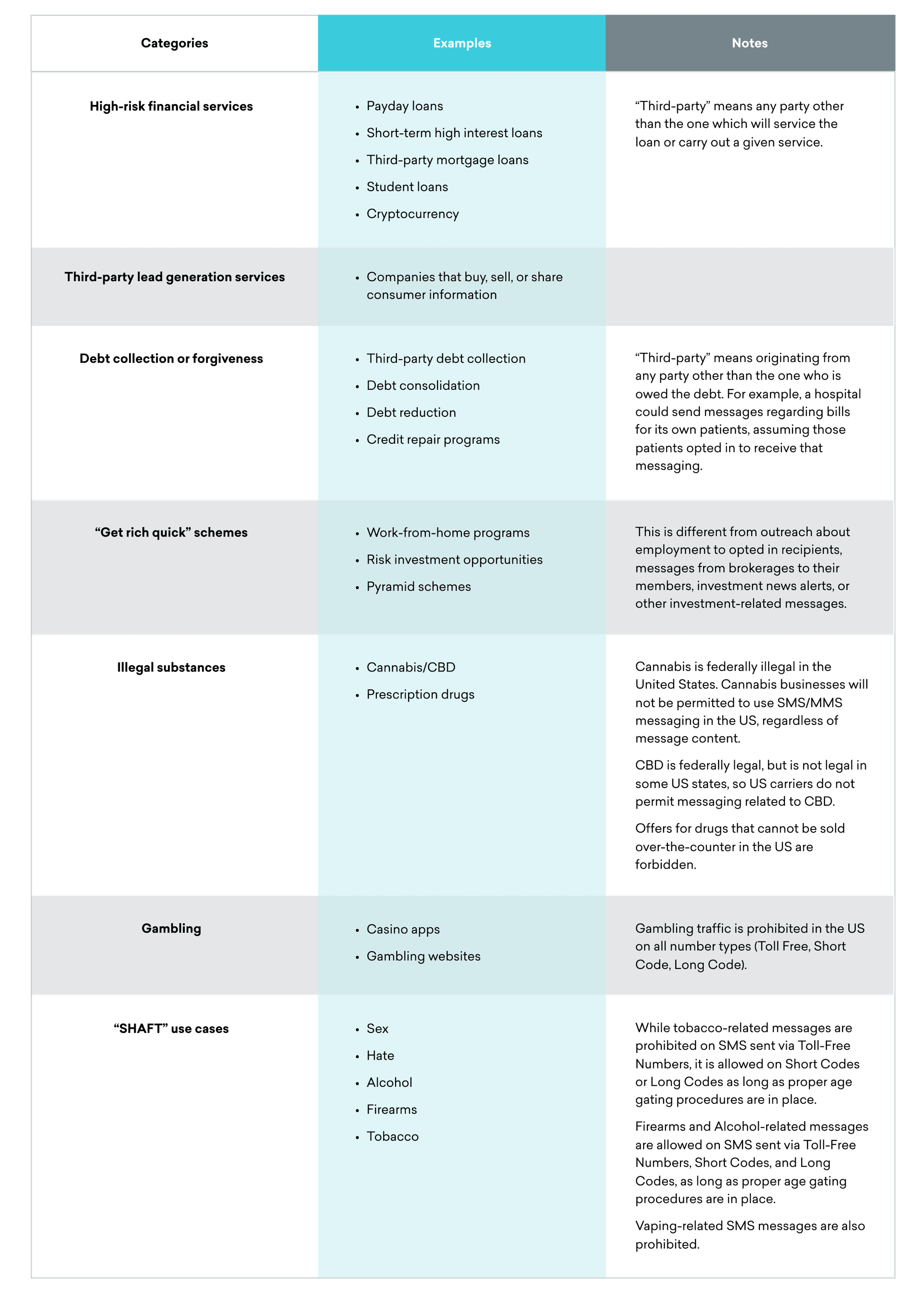Understanding SMS: 10DLC and Forbidden Message Topics
Published on February 10, 2022/Last edited on February 10, 2022/6 min read


Jennifer Keck
CopywriterShort, text-based messaging types are having a moment, with the number of SMS messages sent in the US rising by 10% between 2018 and 2020, from 2 trillion to 2.2 trillion. This rising usage includes significant use of this channel for marketing purposes—and it’s easy to see why. SMS messages offer brands a fast and effective way to send marketing messages, transactional notifications, customer support, and more.
From short codes and text-powered ads to major SMS-driven brand campaigns, SMS has continued to evolve to meet the demands of mobile marketing. Its latest innovation, the 10-digit long code or 10DLC, serves as a new and improved method of reaching customers. If you leverage SMS in your customer engagement programs—or plan to—it’s important to understand what 10DLC is, how to use it, and how the topics you include in the messages you send can impact your marketing.
What Is 10DLC?
To really wrap your head around what 10DLC is and what makes it special, there are four key SMS terms and concepts that you need to understand:
- Person-to-person (P2P) messaging: This type of messaging was initially developed to allow individuals to exchange messages with each other.
- Application-to-person (A2P) messaging: This messaging system was developed for mass texting and was once exclusively used for short codes.
- Long codes: These standard 10-digit phone numbers are designated for P2P communication, but have also been adopted by brands in some circumstances to support their SMS marketing programs. Long codes often serve as a low-cost alternative to short codes, but can only send one message per segment per second. They are also subject to carrier filtering and higher message rejection rates, compared to short codes.
- Short codes: These five or six-digit codes are specifically designated for A2P messaging. They allow brands to send a high volume of messages with a throughput that ranges from 100 to 300 message segments per second. However, short codes can be expensive and aren’t suited for all the different ways that brands built out their SMS messaging campaigns.
What does this mean when it comes to 10DLC? Remember how long codes were originally designated for consumer use? Well, thanks to the introduction of the A2P 10-digit long code (10DLC) in the US, brands can route SMS messages on long codes through designated A2P traffic. Because brands send these messages through a system that’s designated for commercial purposes, they have higher deliverability rates and lower filtering risks than in the past.
These numbers not only help to address deliverability issues, but also legitimize long codes for mass texting campaigns. And they provide brands with the best of both worlds: Higher volume and speed at lower costs.
10DLC and Forbidden Messages
However, the same rules that apply to short codes and toll-free messaging in the US also apply to 10DLC (which is currently only available in the US), including prohibitions on using SMS to send messages that deal with a range of different topics. Failure to comply with this guidance can potentially lead to registry termination by the CTIA, a trade association representing the wireless communications industry in the United States, and impacted carriers, significantly harming your ability to continue reaching customers through this channel.
Read on for a list of message topics that are currently forbidden in the US:

In addition to forbidden messages, there are other rules to be aware of when it comes to SMS content, even when the use case in question isn’t forbidden. The use of shared public URL shorteners isn’t allowed by US carriers and will be filtered, for example. For more information on SMS messaging best practices and how to ensure your campaign is compliant, check out our recent blog on the topic.
How Marketers Can Respond to a Changing SMS Regulatory Landscape
With the introduction of 10DLC, we’re seeing a significant shift in the SMS marketing landscape, reflecting the fact that this channel is becoming more universally regulated across all sending phone numbers in the US. Given this reality, the key question for brands is: How should marketers prepare?
1. Register your long codes for 10DLC if you haven’t done so already. While 10DLC rollout is still in early stages, we expect it to become the next standard across all US carriers for brands looking to send text messages over long codes. The longer you wait, the more the performance of your campaigns will suffer from heavy filtering and rejections rates—not to mention higher carrier fees for all unregistered traffic (i.e. messages sent over regular long codes).
2. Use other channels to engage your audiences. Most brands won’t be impacted by the new regulations imposed with 10DLC. But if your industry happens to be one of the ones that is directly affected, you still have plenty of options. One good one? Consider leveraging other channels like email to expand your reach and invest in testing and optimizing your marketing programs to drive more impact over the long haul.
3. Engage your legal team for an internal audit of your SMS marketing program. SMS regulations evolve constantly, because carriers are empowered to develop their own safeguards and enforce them to protect consumers. So SMS due diligence is not a one-and-done affair. It’s a good idea to develop an internal process that includes regular audits with your Legal team to stay on top of all developments related to SMS—and that’s true even if your industry is typically not subject to regulatory scrutiny. Better safe than sorry, right?
And keep in mind that at the end of the day, these regulations are meant to protect consumers, which means that by being compliant you are providing a better and more secure experience to your customers.
Final Thoughts
While 10DLC serves as an innovative tool in any marketer’s SMS toolbox, learning how to build effective, compliant campaigns is essential if you want to get the most from it. Fortunately, that’s easier than it sounds. With Braze, you can develop personalized SMS campaigns that boost engagement, improve retention, and increase sales. By sending targeted messages based on user behaviors and interests, you can rest assured that your recipients receive the right marketing offer, transactional update, or customer assistance at the right time.
Interested in learning more about how Braze can take your SMS marketing to the next level? Contact us today!
Related Tags
Be Absolutely Engaging.™
Sign up for regular updates from Braze.
Related Content
View the Blog
How behavioral marketing turns data into personalized experiences

Team Braze

Are you AI-savvy enough to survive? A wake-up call for CMOs

Team Braze

What are contextual bandits? The AI behind smarter, real-time personalization
